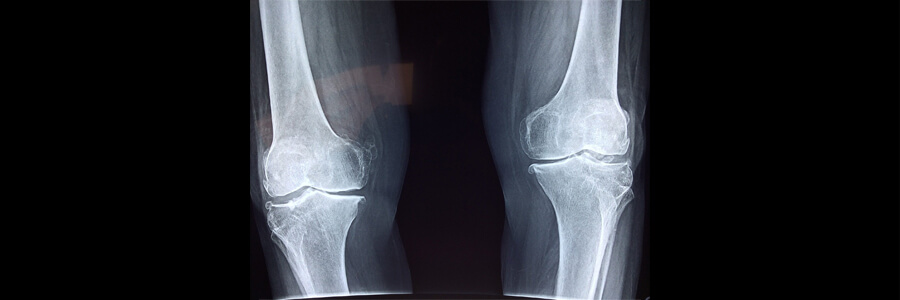
Osteoarthritis is the most common form of arthritis and is a chronic joint condition, caused by a joint damage and affecting millions of people worldwide. Osteoarthritis in the knee can affect everyone, but it usually develops for people over the age of 50. It is a progressive disease, which means that it develops and it becomes increasingly painful and more difficult for the knee to move over time. Causing implications such as pain, stiffness and swollen joints, osteoarthritis needs treatment for relief!
Lifestyle modifications is a first step, and before surgery might be necessary and when other arthritis medications have been tried without success, knee injections, such as Monovisc, Supartz and Orthovisc can be helpful in relieving the pain and thereby have a great impact on the quality of osteoarthritis patients’ everyday life.
Read further here to get a quick overview of osteoarthritis and understand how knee injections can help relieve this disease.
WHAT IS OSTEOARTHRITIS?
Osteoarthritis is the most common chronic condition of the joints. It can affect any joint in the body, but is most likely to affect the joints that bear most of the body weight, such as the knee and feet. The joint of the hand which we use a lot in everyday life, are also commonly affected. Besides, hips and spine are also commonly affected.
Osteoarthritis is a condition which occurs when the cartilage that cushions the ends of bones in your joints gradually deteriorates. Cartilage is a firm, slippery tissue that enables nearly frictionless joint motion. Eventually, if the cartilage wears down completely, the bones of the joints rub more closely against one another with less shock-absorbing benefits of cartilage. This condition is osteoarthritis.
RISK FACTORS AND SYMPTOMS
While age is a major risk factor, and the condition usually occurs over the age of 50, young people can get it too. As explained by the Mayo Clinic there are other risk factors leading to osteoarthritis as well. These factors include injuries, overweight, infections, certain metabolic diseases and even genetics.
Some of the symptoms of osteoarthritis are pain, swelling, stiffness and decrease in mobility in the knee. The diagnosis will be set by the doctor, and the procedure afterwards is to look at treatment to relieve pain and return mobility. Considering these fundamentals of osteoarthritis, we can look deeper into what and how knee injections can do for osteoarthritis in the knee joints.
INJECTIONS FOR TREATMENT OF OSTEOARTHRITIS
Injections are one of the treatments that can help patients with the pain they experienced due to osteoarthritis. There are two main injection treatments available to treat osteoarthritis in the knee; corticosteroid injections that provide an anti-inflammatory medication directly to the knee joint and the hyaluronic acid treatment that replace a naturally-occurring lubricant in the fluids around the knee joint.
First, corticosteroid injections act in a similar way to the hormone cortisol. Cortisol works on the immune system to reduce inflammation throughout the body and also serves to reduce pain. This type works faster than hyaluronic acid injections, but the effect does not last as long. However, for some people, corticosteroid injections help relieve pain and improve the joint movement, but for others it does not have the hoped effect.
Second, we have the hyaluronic acid injection. A healthy knee joint contains up to 4mL of joint fluid and hyaluronic acid is a key component of this fluid. Joints affected by osteoarthritis typically have a lower concentration of hyaluronic acid and have therefore less protection against joint friction. These injections can therefore help restore normal levels, that will lubricate the joint and it may also reduce inflammation.
The effect of hyaluronic acid is slower than with corticosteroid injections, however the risk is lower and the hyaluronic acid injection can be considered to be a more natural way, relying on a natural fluid in the body. Both types requires going to the doctor to have the injection.
Three of the most common and approved hyaluronic acid injections are monovisc, supartz and orthovisc.
In the following, the injection of Monovisc will be explained, an injection type for knee joints that only requires a single injection treatment.
THE MONOVISC INJECTION
Monovisc is a gel substance hyaluronic acid injection and the only non-animal sourced type. It has the strong benefit for patients that it is a single injection treatment, that still lasts up to 6 months.
Monovisc injections has a very high concentration of hyaluronic acid which maximizes the potential for impacting the osteoarthritic cell function. What is interesting and effective about hyaluronic acid injections are that it actually can restore native hyaluronic acid production.
Side effects of Monovisc are of course natural and important to consider. The most common ones are a pain in the knee, bruising, warmth and a slight swelling. They should resolve after a few days though and discomfort and swelling can be reduced by putting a bag of ice on the knee. In rare cases bleeding, infection or an allergic reaction can occur.
Osteoarthritis can with its complications have a great impact on the daily life. Therefore, it is important to consider to consider the different types of treatments to relieve the complications, so it will still be possible to live an active life and go through the day without pain. Knee injections can create a base for decreasing and reliving the pain that patients with osteoarthritis in the knee joints can experience.
Please share with: ![]() Linkedin.com
Linkedin.com ![]() Reddit.com
Reddit.com

